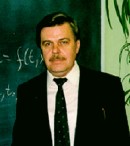
Plenary Lecture
Limit Cycles in Two-Dimensional Quadratic Systems: Analytical Methods and Visualization

Professor Gennady A. Leonov
co-authors: N. V. Kuznetsov, S. M. Seledzhi
St. Petersburg State University
Russia
E-mail: leonov@math.spbu.ru
Abstract: The study of limit cycles of two-dimensional dynamical systems was stimulated by purely mathematical problems (the center-and-focus problem, Hilbert’s sixteenth problem, and isochronous centers problem) as well as many applied problems (the oscillations of electronic generators and electrical machines, the dynamics of populations). In 1901 Hilbert, in his famous 16-th problem, posed a problem of the analysis of relative disposition and the number of limit cycles for two-dimensional polynomial systems. At the present time there exist different methods for "construction" of limit cycles. For a more than century history, in the framework of the solution of this problem the numerous theoretical and numerical results were obtained. But the problem is still far from being resolved even for the class of quadratic systems The appearance of modern computers permits one to use numerical simulation of complicated nonlinear dynamical systems and to obtain new information on the structure of their trajectories. However the possibilities of "simple" approach, based on the construction of trajectories by numerical integration of the considered differential equations, turned out to be highly limited. Academician V.I Arnol’d writes in his book: "To estimate the number of limit cycles of square vector fields on plane, A.N. Kolmogorov had distributed several hundreds of such fields (with randomly chosen coefficients of quadratic expressions) among a few hundreds of students of Mechanics and Mathematics Faculty of Moscow State University as a mathematical practice. Each student had to find the number of limit cycles of a field. The result of this experiment was absolutely unexpected: not a single field had a limit cycle! It is known that a limit cycle persists under a small change of field coefficients. Therefore, the systems with one, two, three (and even, as has become known later, four) limit cycles form an open set in the space of coefficients, and so for a random choice of polynomial coefficients, the probability of hitting in it is positive. The fact that this did not occur suggests that the above-mentioned probabilities are, apparently, small." In this lecture the effective analytical and numerical method for investigation and visualization of limit cycles will be discussed.
Brief Biography of the Speaker: Gennady A. Leonov received his PhD (Candidate Degree) in mathematical cybernetics from Saint-Petersburg State University in 1971 and Dr.Sci. in 1983. From 1985 – he is full professor at the Mathematics and Mechanics Faculty. He has been vice-rector of Saint-Petersburg State University from 1986 to 1988. Now Gennady A. Leonov is Dean of Mathematics and Mechanics Faculty (since 1988), Director of Research Institute of Mathematics and Mechanics of St.-Petersburg State University (since 2004), Head of Applied cybernetics Department (since 2007). Professor G.A. Leonov authored and co-authored 300 books and papers. His research interests, now in qualitative theory of dynamical systems, stabilization, nonlinear analysis of phase synchronization systems and electrical machines.